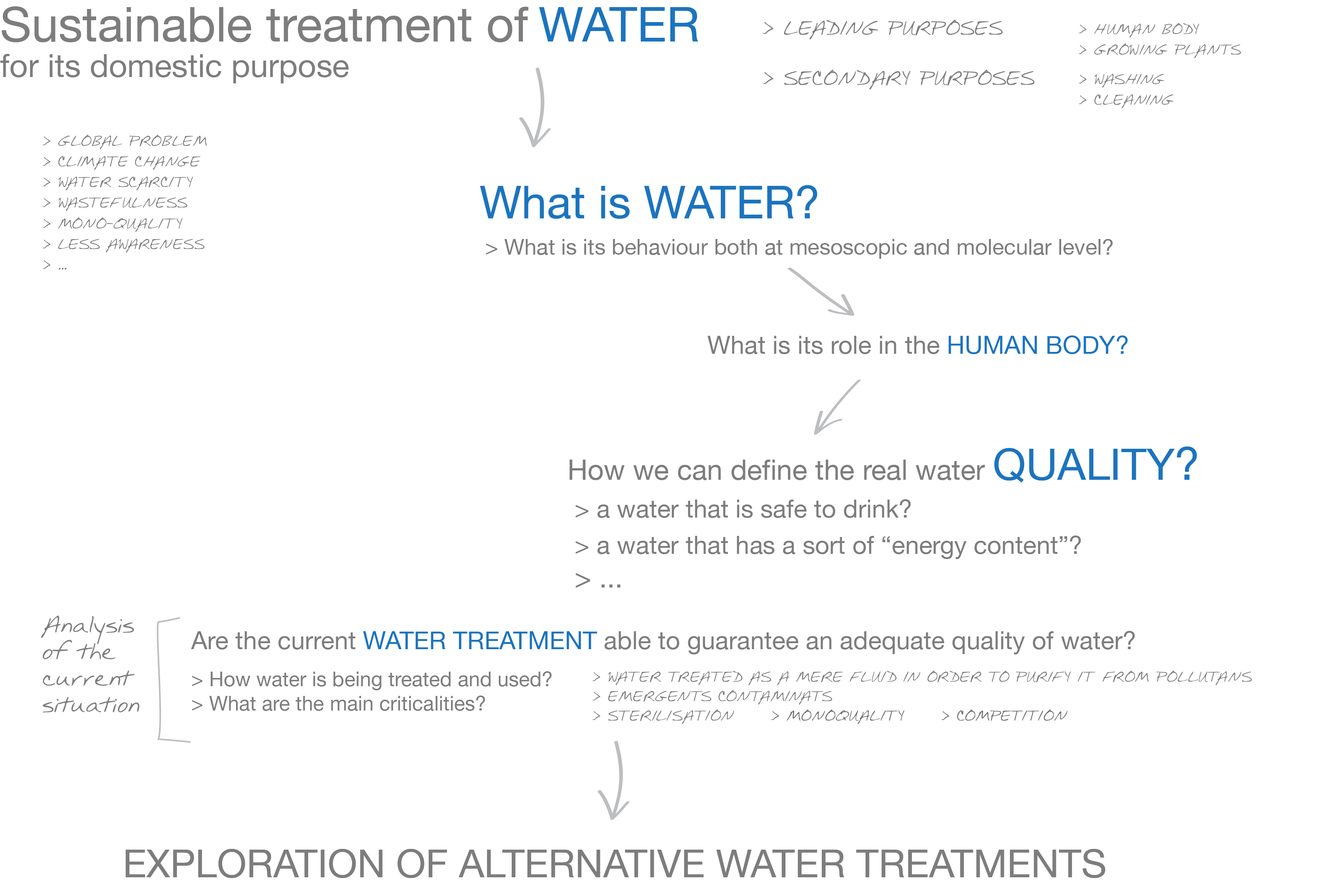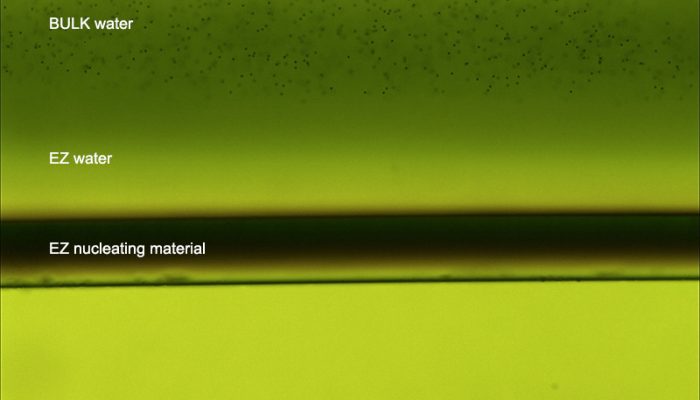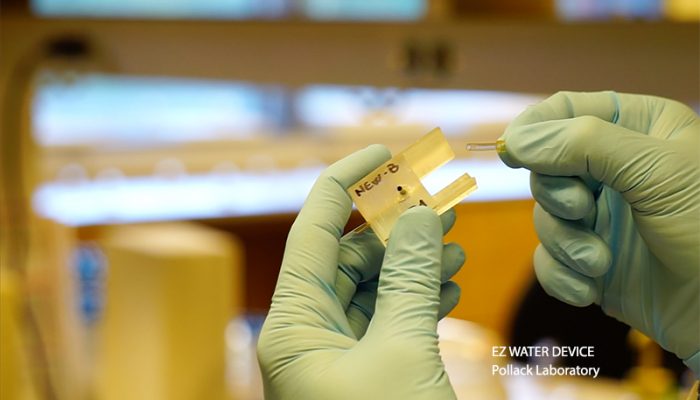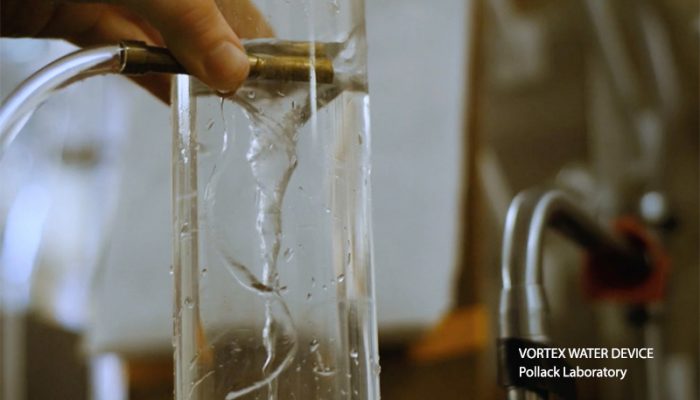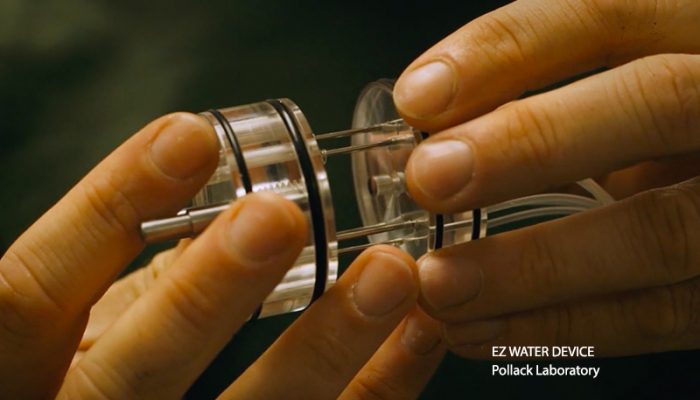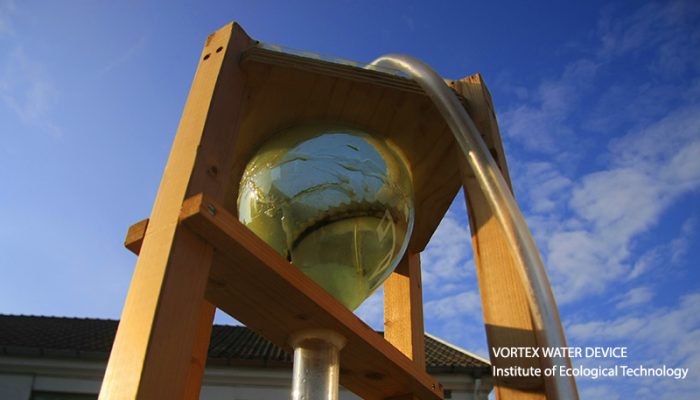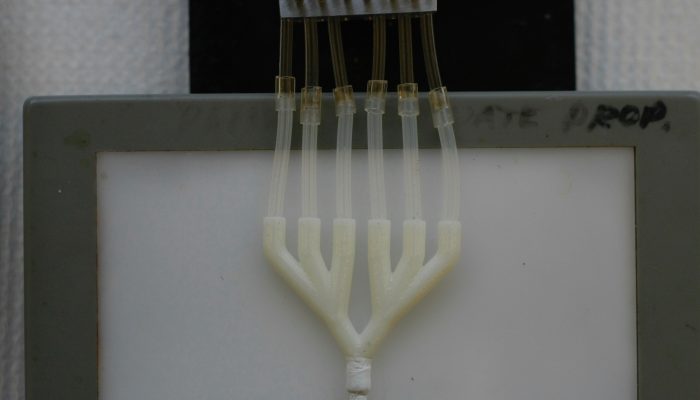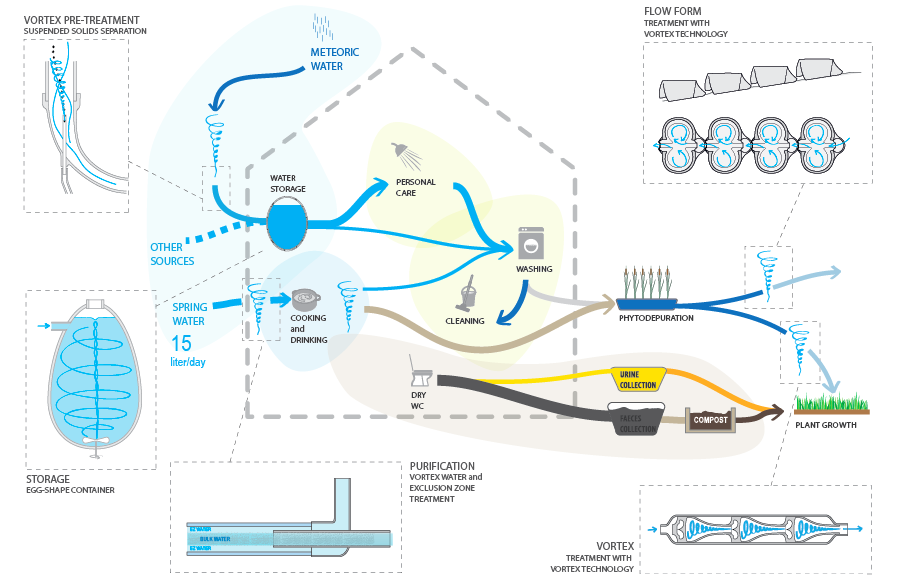2011-2014 | Politecnico di Torino – University of Washington- SMAT
The PhD Research was focused on the application of the Systemic Design (SD) methodology to the water treatment for domestic purposes. It was performed at Politecnico di Torino in collaboration with SMAT, the Metropolitan Water Company in Turin (Italy), and the Pollack Laboratory (University of Washington).
The main focus of the Research activity has been the rethinking of the water flows within the house system with the aim to drastically reconsider the water usage at domestic level in order to reduce the amount of water needed as input, and to completely recycle all the outputs by generating a wastewater-free system.
In particular the Systemic Design methodology here adopted has been developed with the aim of implementing sustainable productive systems in which material and energy flows are designed so that waste from one productive process becomes input for other processes, avoiding being released into the environment. This model is inspired by the theoretical structure of generative science, according to which every modification in resources generates by-products which represent an added value. Starting from the observation of natural phenomena, the SD approach aims to “learn from nature” not just for mimicking the natural technologies, but for designing a product system able to positively interact with a dynamic environment and an evolving society.
The state of the art of the methods used to disinfect and decontaminate water and to reuse wastewater or to desalinate seawater, is working in concert to improve health, safeguard the environment, and reduce water scarcity. However, despite modern science is able to investigate water very deeply and even though the efficiency of water purification technologies has increased tremendously in the latest years, many properties of liquid water still remain incompletely understood. Yet, a more profound comprehension of the water behavior can lead to turn the light on the many mysteries of this incredible substance.
The SD methodology drove the research through an intense exploration of the complex properties of liquid water touching a variety of disciplines from physics to chemistry until bioengineering and medicine that has opened the frontiers to a more holistic understanding of water.
According to this systemic vision, water has been interpreted as an open and self-regulating system, an interpretation at the basis of the recognition of some peculiar properties of water such as the ability to carry information, to self depurate and structure itself in relation to the stimuli received: the recognition of the intelligence of water, something that goes beyond what the chemical formula H2O can express.
In particular the Research focus moved towards the development of a water purification system able to enhance the qualities of water for specific house appliances, by adopting membrane-less and chemical-free water treatment technologies in order to reduce the amount of water needed and to eliminate the harmful by-products.
During the PhD program I had the great opportunity to collaborate with the Pollack Laboratory at the University of Washington (Seattle, WA) in order to develop an innovative water purification system based on the Exclusion Zone (EZ) phenomenon. The Exclusion Zone (EZ) is an interfacial water region that has a lower concentration of solutes than in the bulk water. The purification technology based on the EZ phenomenon has a high innovation rate since the purification occurs without any physical filter, which obviates the need for filter replacement or cleaning. We obtained remarkable results on separation of various suspended and dissolved substances that encourage us to go further in the technology development.
The “filter-less” water purification system based on the Exclusion Zone phenomenon was selected as a finalist at the Gulf Coast Innovation Challenge 2015.
After one more year of research activity as postdoctoral fellow at Pollack’s Lab, together with G.H.Pollack, Chris Gronet and Kurt Kung I’ve recently started a Company, 4th-Phase, Inc. with the aim to commercialize a filtration device based on this technology.
Meanwhile, at the IET (Malmo, Sweden) I’ve experienced the vortex technology to clean out suspended solids without any physical barrier or chemical agent. Lab testing proved a separation of Suspended Solids and Natural Organic Matter over the 96-98% in a single pass.
Thanks to the development of such innovative technologies I was able to design a completely new house system.
The new house system is here considered as a “living organism” where water is treated using membrane-less and chemical-free purification modules that take advantages of the spontaneous solutes rejection in the vicinity of some hydrophilic surfaces or in a free-vortex.
” Water represents the origin and the destination, for these reasons attracts us and scares us. Water pushes us to look inside, to discover things we do not want to see, the fears we bring in from countless generations. Watching water does not mean to look at its surface, but penetrating its transparency and exploring its nature, our nature. […] Everything emerged from the water. Water, therefore, is the raw material of every culture and the basis of every somatic and spiritual development. The discovery of the secrets of water renders meaningless all the speculations that lead to war, hatred, envy, intolerance and discord ” – Viktor Schauberger
PUBLICATIONS
\\Elia V., Oliva R., Napoli E., Germano R., Pinto G., Lista L, Niccoli M., Toso D., Vitiello G., Trifuoggi M., Giarra A., Yinnon T. A., (2018) Experimental study of physicochemicalchanges in water by iterative contact with hydrophilic polymers: A comparison betweenCellulose and Nafion. Molliq, doi:10.1016/j.molliq.2018.07.045
\\Toso D., (2017) The Systemic Design approach for understanding the water social behavior. In Proceedings of Relating Systems Thinking and Design (RSD6) 2017 Symposium. Oslo, Norway, October 18-20, 2017. ISSN 2371-8404
\\Toso D., (2017) New findings in water purification treatment: Free Vortex Technology. In: 12th Water Conference – Conference on the Physics, Chemistry and Biology of Water, Sofia, Bulgaria, 26 – 29 October, 2017
\\Abha Sharma, Dario Toso, Kurt Kung, Gun-Woong Bahng, and Gerald H. Pollack (2017) QELBY„-Induced Enhancement of Exclusion Zone Buildup and Seed Germination – Advances in Materials Science and Engineering, 2017
\\Toso Dario (2015), Visione Sistemica dell’Acqua. PhD Thesis in Ecodesign
\\Toso D., (2015) New findings in water purification treatment. In: 10th Water Conference – Conference on the Physics, Chemistry and Biology of Water, Varna, Bulgaria, 1 – 3 October, 2015
\\Toso D., Binetti R., Brussolo E., Bistagnino L., Meucci L. (2015) Exclusion Zone: studio di fattibilità di trattamenti innovative nel settore acquedottistico – Industry and Chemistry (Pro-Medianet) n. 4 Luglio-Agosto ’15
\\Toso D., (2014) Systemic Design applied to the water treatment for its domestic purpose: The Exclusion Zone and the Vortex Technology. In: 9th Water Conference – Conference on the Physics, Chemistry and Biology of Water, Pamporovo, Bulgaria, 8 – 12 October, 2014
\\Toso D. Re T. (2014) Systemic Design applied to the water treatment for its domestic purpose – URBAN WATER 2014 – Algarve, Portugal, 27-29 May 2014
\\Toso D. (2013) Systemic Design applied to the water treatment for its domestic purpose – ICWRER 2013 – Koblenz Germany, 6-8 June 2013.
CREDITS:
Ph.D in collaboration with: Politecnico di Torino (DAD) | SMAT | University of Washington (BIOE)
Academic Tutor: prof. Luigi Bistagnino | Co-tutor: prof. Gerald H. Pollack
Candidate: Dario Toso
Experimental analysis: Pollack laboratory (UW) | SMAT Research Centre
Financial support: SMAT, S.p.A.

